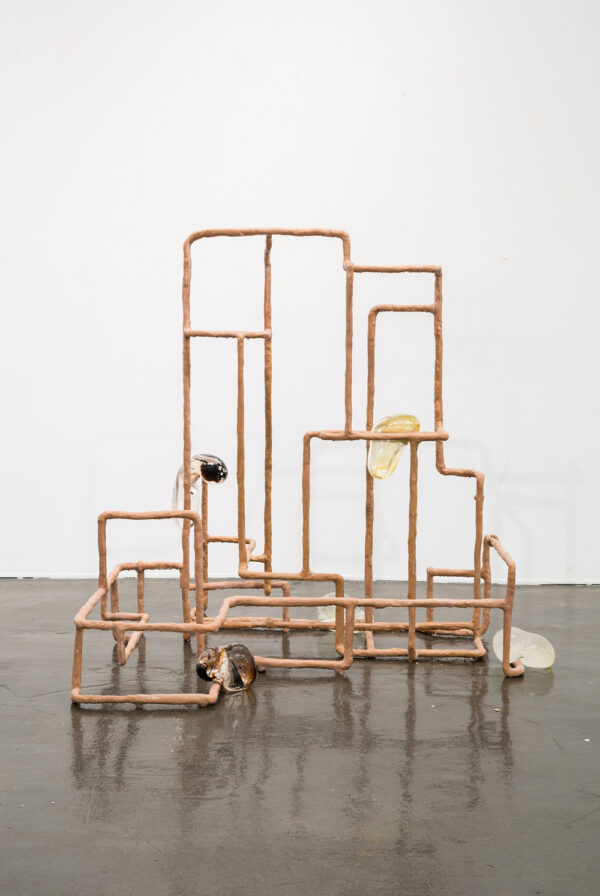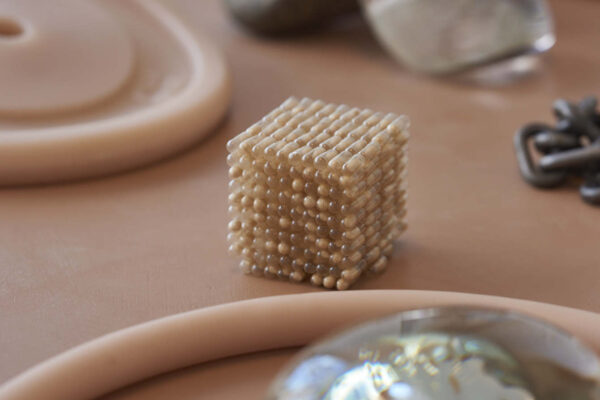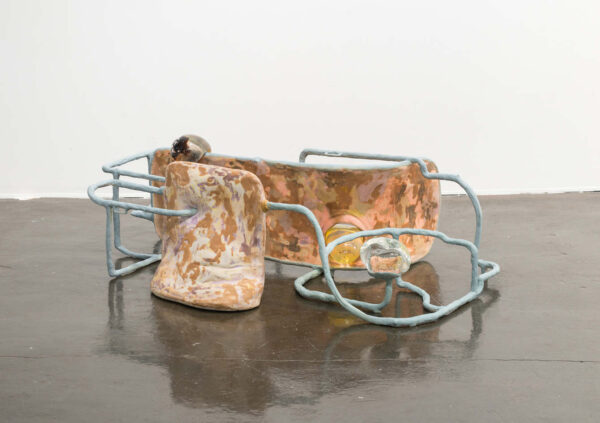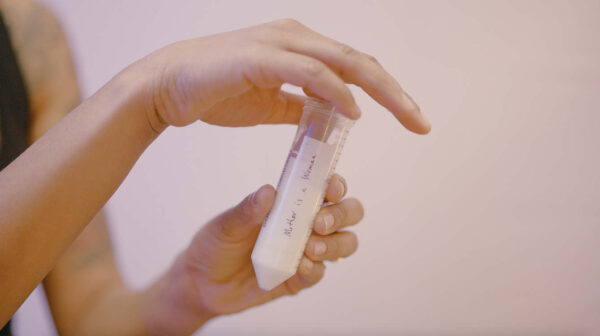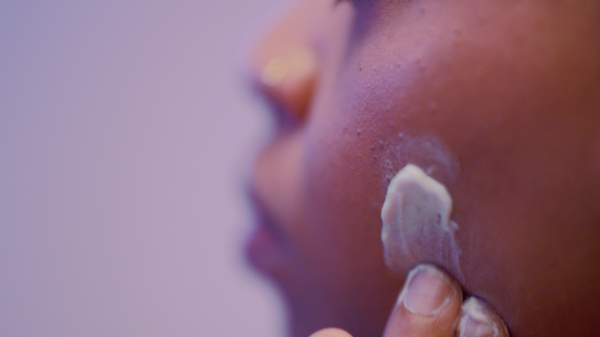
(Dis)Embodying the biomolecular sex: The lapse of identity in Jes Fan’s hormone works (2017 – 2018)
[This blog post was commissioned by The Courtauld’s Gender & Sexuality Research Group, published 3 December 2020]
To borrow the terms of the American feminist Donna J. Haraway, the twenty-first-century body is a technoliving system, the result of an irreversible implosion of modern binaries (female/male, animal/ human, nature/culture).
— Paul. B. Preciado, 2013[1]
The contemporary condition of the body as a ‘technoliving system’ is meticulously mapped onto Jes Fan’s precarious sculptures, through which the artist wishes to challenge binary conceptions of gender, race, and identity. In their 2018 sculptural series titled Systems, Fan isolates testosterone, estrogen and melanin from the human body and lets them float freely in their hand-blown glass globules. Rendered in biomorphic shapes recalling human organs and drops of body fluids, the limpid glass objects slothfully hang on a piping system which the artist called ‘lattice’, as if in the process of leaking, or seeping out (Fig. 1).[2] Not dissimilar to lattice normally used as a support for climbing plants, the vine-like pipeline used in Fan’s works is, for them, a ‘living shelf’— or at least, a semi-living one, for the sex hormones and melanin contained in the glass vessels are perpetually in flux.[3]
The material process of glass comes in a state of flux too. Glass as a material gains liquidity when it is heated and is malleable because it is able to store the heat for a while. The beginning of the documentary film Jes Fan in Flux (2019) shows an alchemical process of glass-making: glass comes out of the kiln in the form of a hot bubble, and the artist blows it on plaster that bears the imprint of the body part of their friend.[4] To Fan, glass blowing is ‘a huge Venn diagram for [their] obsession with vessels and containers.’ [5] Glass does not function as a means to an end in Fan’s work, but with its pliable materiality and processes serves as a metaphor for a constant state of transitioning, which is intimately linked not only to the artist’s own migration between different geographical and cultural loci, but also to their experience of transformation in gender and sex.[6] Stereotypical misconceptions about gender as a social identity often claim it is solely or largely the product of hormones.[7] But while hormones may have historically informed interpretations of gender; gender itself is not fixed, static, or ahistorical, nor limited to the bodies that contain it. Fan’s glass capsules contain and thus isolate the hormones from the context of the human body, delinking them from any norms or images associated with the masculine or the feminine. In other words, testosterone and estrogen are ‘prevented’ from getting translated as images of masculinity or femininity. Therefore, Fan’s deployment of hormones as a material does not confirm the essentialist view that hormones necessarily ‘produce’ gender, but on the contrary, encourages us to examine the significance of these politically contested materials that are normally invisible to the human eye.
Further than that, male and female sex hormones often co-exist in Fan’s work. In Systems III (2018), the artist incorporates large pieces of resin sanded to ‘skin-like smoothness’, revealing patches of different colours found on human skins.[8] A glass globule containing progesterone penetrates the resin plane like a drop of serum traveling through the pore of the skin into the endocrinological system of the body, while an orb holding a small amount of testosterone is already there resting upon the vein-like lattice (Fig. 3). Suggestive of the body systems that are porous and malleable, Systems III seems in congruence with the non-binary line of thought, which holds that the body consists of ‘a complicated array of masculine and feminine characteristics’[9] and is able to produce both androgens and estrogens under certain conditions and circumstances.[10]
By visualising the hormones in a quantified manner, Fan also demonstrates how the body is reconfigured in a molecular and informational terms entangled in what Paul B. Preciado calls ‘the condition of life in the pharmacopornographic era.’[11] ‘Pharmacopornographic’ is a term that refers to the government of sexual subjectivity through ‘biomolecular (pharmaco)’ and ‘semiotic-technical (pornographic)’ processes.[12] That sexualities are measured in biomolecular, tangible terms characterises the pharmacopornographic biocapitalism. Having the experience of transitioning themselves, Fan is fully aware of this regime. They were intrigued by the idea that masculinity came as a bottle of testosterone tagged with a price.[13]They did a systematic research into how steroid hormones were pharmaceutically produced and discovered that both testosterone and estrogen available for sale on the market came from soybean phytosterols.[14] This finding that an androgynous identity symbolically inhabits a soybean leads to their installation work Animacy Arrangement (2017), for which the artist packed soybeans into capsules and organised them into a cube structure (Fig. 2).
Although the artist identifies as trans, they are skeptical of any normative representations and acts that demarcate what alternative genders is supposed to look like. Over the course of their transition, Fan has learned codes and norms associated with masculinity that were unfamiliar to them, and at the same time, unlearned what they had been taught previously.[15] Only at later time they realised the performative nature of these acts, and decided to ‘unlearn what [they] took from the lessons of trying to attain machismo.’[16] The process of unlearning is for them ‘not always comfortable.’[17] It might be this discomfort that sharpened the artist’s awareness of the surface of their body, because, as Sara Ahmed poignantly points out, the inability to inhabit the norms (surface as the social skin) produces a feeling of estrangement and disorientation that will generate an awareness acute as such.[18] Skin is indeed very present in Fan’s work. From Diagram I-V and Systems III to their four-minute, forty-four-second video work Mother is a Woman (2018), Fan reflects on the epidermis as a site of identification, a vessel of othering and queer feeling.
‘Mother is a Woman’ is eponymously the name of a custom beauty cream, the essence of which is extracted from urine of the artist’s mother (Fig. 4). The film begins with a close-up shot of the cream contained in a test tube followed by the detailed procedure of extracting estrogen from the mother’s urine in a laboratory setting. The video switches between scenes that show the ‘artisanal’ process of extraction and close-ups of men and women actors of different colours rubbing the estrogen cream onto their cheeks (Fig. 5). In the meantime, a female voiceover narrates in first person:
Beyond a beauty cream, Mother Is a Woman invites you to rethink kinship through the pores of your skin. Can our epidermis be the first contact of kinship? As your skin absorbs my mother’s estrogen, you are feminised by her. Mother is a Womanasks, ‘Who are you to her?’ And, ‘Who are you to me?’[19]
The work not only gently challenges conventional and stereotypical representations of gender that underlie commercial beauty advertisement, but also proposes the possibility of queer kinship—of ‘creating intimacies that are not based on biological ties.’[20] Through an elder Asian woman’s urine, the queer subject finds the pleasure of opening up to other bodies via contacts on the skin. They build up a social bonding, or in Fan’s terms, ‘an entanglement’ which may effectively help them accommodate the sense of discomfort with normative ways of living.
About the author
Sophie X. Guo is a PhD candidate working under the supervision of Dr Wenny Teo at The Courtauld Institute of Art. Her doctoral thesis examines how biomedicine and biotechnology transform image making in Sinophone cultures from the late 1980s to the present day, with a particular focus on the conceptions of gender, sexuality, subjectivity, and ecology. She previously completed her MA and BA degrees in History of Art at the University College London.
References
[1] Paul B. Preciado, Testo Junkie: Sex, Drugs and Biopolitics in the Pharmacopornographic Era. Trans. Bruce Benderson (New York: The Feminist Press, 2013), 44.
[2] Jes Fan, ‘Jes Fan in Flux’, 15 May 2019, https://art21.org/watch/new-york-close-up/jes-fan-in-flux/ (accessed 15 June 2020).
[3] Jes Fan, ‘Infectious Beauty’, 20 May 2020, https://art21.org/watch/new-york-close-up/jes-fan-infectious-beauty/ (accessed 15 June 2020).
[4] Jan Garden Castro, ‘States of Flux: A Conversation with Jens Fan’, in Sculpture, 15 April 2020, https://sculpturemagazine.art/states-of-flux-a-conversation-with-jes-fan/ (accessed 22 August 2020).
[5] Castro, 2020.
[6] Fan, 2019.
[7] For instance, neuroscientist Joe Herbert believes that testosterone fuels male competition and makes them enjoy taking risks. See Herbert, Testosterone: Sex, Power, and the Will to Win (Oxford; New York: Oxford University Press, 2015).
[8] Glenn Adamson, ‘Jes Fan makes work free of gender binaries’, 30 August 2018, https://www.craftscouncil.org.uk/stories/jes-fan-makes-work-free-gender-binaries (accessed 15 July 2020).
[9] Cordelia Fine quotes D. Joel in Testosterone Rex: Myths of Sex, Science, and Society (New York: W.W. Norton & Company, 2017), 225.
[10] Fine, 228.
[11] Preciado, 28-50.
[12] Preciado, 33-34.
[13] When they first started transitioning, they bought a bottle of testosterone that cost $3 with their healthcare. See Melissa Saenz Gordon, ‘In the Studio’. April 2019. https://art21.org/read/in-the-studio-jes-fan/ (accessed 15 June 2019).
[14] Jan Garden Castro, ‘Jes Fan in their Studio: The Miracle of Gender’, in Sculpture, 4 January 2017, https://blog.sculpture.org/2017/01/04/jes-fan-in-their-studio-the-miracle-of-gender/ (accessed 23 August 2020).
[15] Fan, 2019.
[16] Castro, 2020.
[17] Fan, 2019.
[18] Sara Ahmed, The Cultural Politics of Emotion (Edinburgh: Edinburgh University Press, 2014), 145-148.
[19] Jes Fan, Mother is a Woman, 2018, 4:44, HD, video, colour. https://vimeo.com/263716151.
[20] Ahmed, 154.
